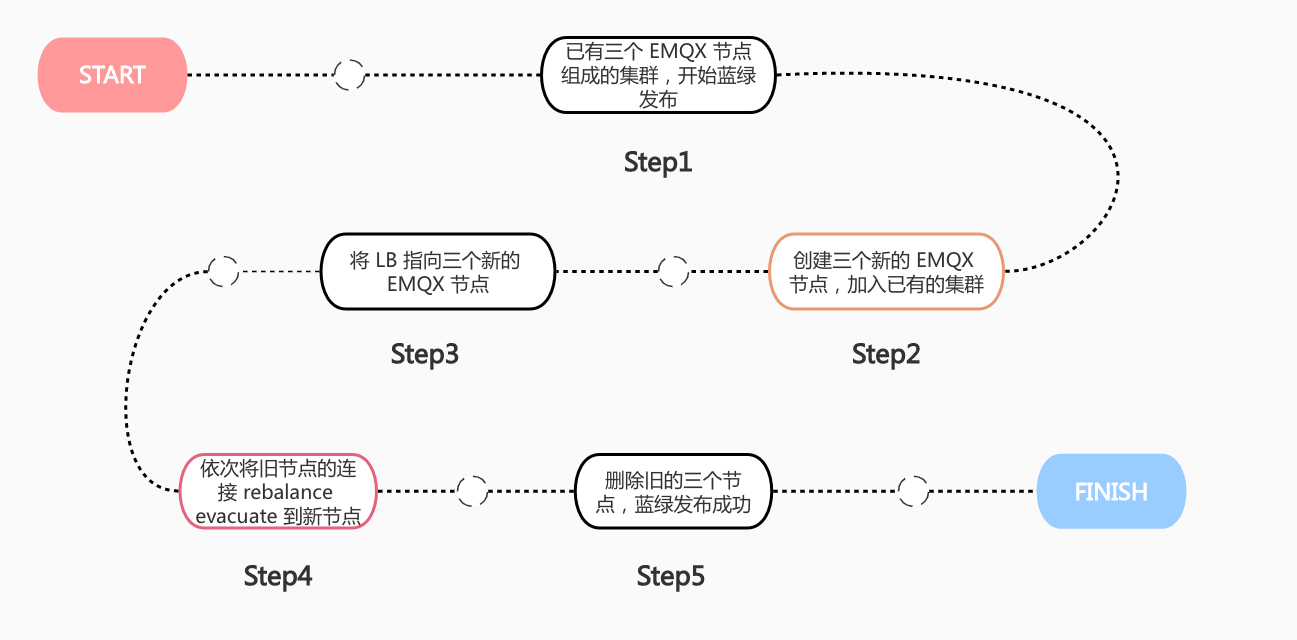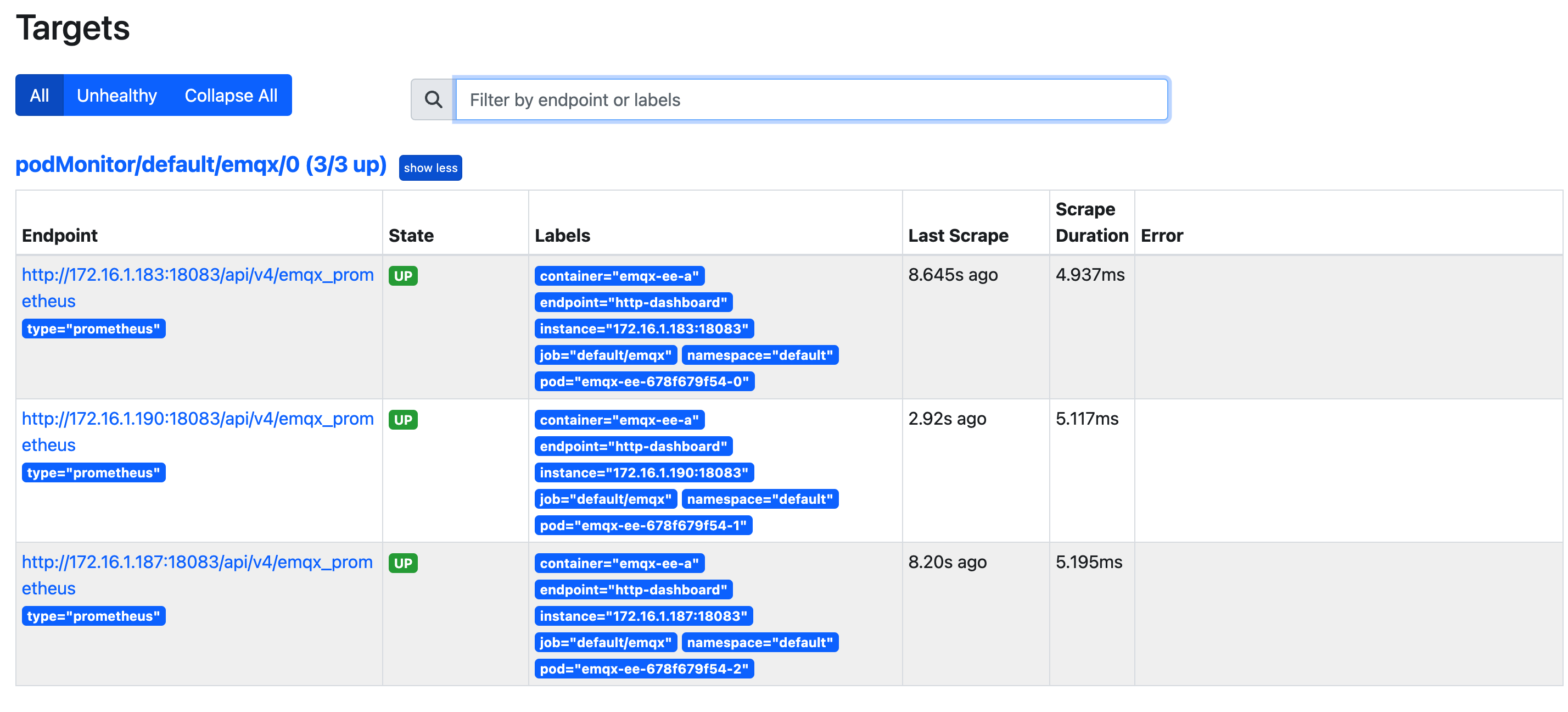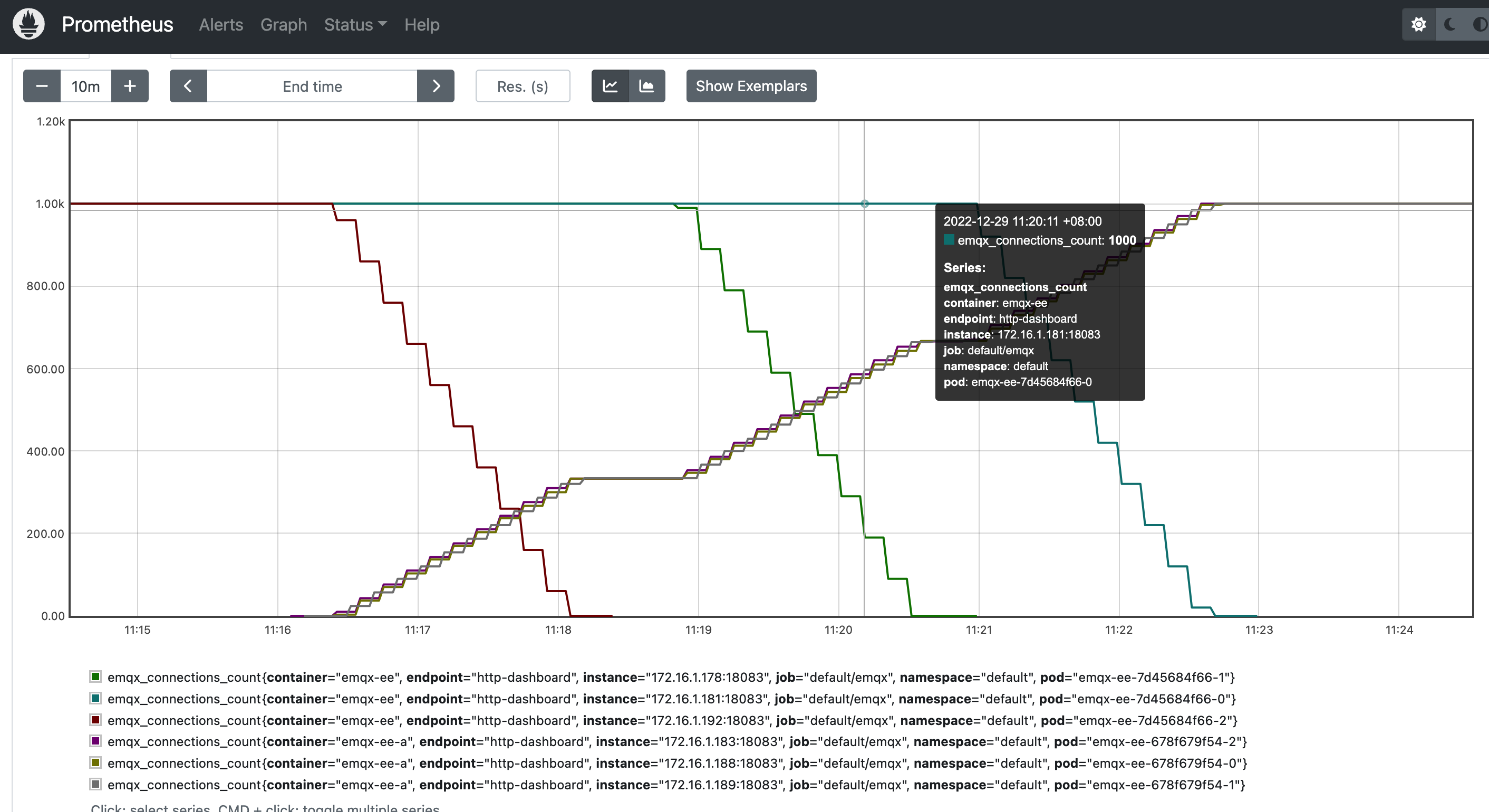# Configure EMQX Enterprise Edition blue-green upgrade
# Task target
- How to use the blueGreenUpdate field to configure the blue-green upgrade of EMQX Enterprise Edition.
# Use the blueGreenUpdate field to configure blue-green update
EMQX provides a long-term connection service. In kubernets, the existing upgrade strategy requires restarting the EMQX service except for hot upgrade. This upgrade strategy will cause disconnection of the device. If the device has a reconnection mechanism, a large number of devices will appear Simultaneously requesting connections, which triggers an avalanche, eventually causing a large number of clients to be temporarily unserviced. Therefore, EMQX Operator implements a blue-green upgrade based on the Node Evacuation function of EMQX Enterprise Edition to solve the above problems. The blue-green upgrade process of EMQX Operator is shown in the figure below:

The EMQX node evacuation function is used to evacuate all connections in the node, and manually/automatically move client connections and sessions to other nodes in the cluster or other clusters. For a detailed introduction to EMQX node evacuation, please refer to the document: Node Evacuation (opens new window). NOTE: The node evacuation function is only available in EMQX Enterprise Edition 4.4.12.
- Configure EMQX cluster
The corresponding CRD of EMQX Enterprise Edition in EMQX Operator is EmqxEnterprise. EmqxEnterprise supports configuring the blue-green upgrade of EMQX Enterprise Edition through the .spec.blueGreenUpdate field. For the specific description of the blueGreenUpdate field, please refer to: blueGreenUpdate (opens new window).
apiVersion: apps.emqx.io/v1beta4
kind: EmqxEnterprise
metadata:
name: emqx-ee
spec:
replicas: 3
license:
stringData: |
-----BEGIN CERTIFICATE-----
...
-----END CERTIFICATE-----
blueGreenUpdate:
initialDelaySeconds: 5
evacuationStrategy:
waitTakeover: 5
connEvictRate: 10
sessEvictRate: 10
template:
spec:
emqxContainer:
image:
repository: emqx/emqx-ee
version: 4.4.14
ports:
- name: "http-dashboard"
containerPort: 18083
serviceTemplate:
spec:
type: NodePort
ports:
- name: "mqtt-tcp-1883"
protocol: "TCP"
port: 1883
targetPort: 1883
nodePort: 32010
2
3
4
5
6
7
8
9
10
11
12
13
14
15
16
17
18
19
20
21
22
23
24
25
26
27
28
29
30
31
32
33
34
35
NOTE: waitTakeover indicates the waiting time (unit is second) before the current node starts session evacuation. connEvictRate indicates the client disconnection rate of the current node (unit: count/second). sessEvictRate indicates the current node client session evacuation rate (unit: count/second). The .spec.license.stringData field is filled with the content of the license certificate. In this article, the content of this field is omitted. Please fill it with the content of your own certificate.
Save the above content as: emqx-update.yaml, execute the following command to deploy the EMQX Enterprise Edition cluster:
kubectl apply -f emqx-update.yaml
The output is similar to:
emqxenterprise.apps.emqx.io/emqx-ee created
- Check whether the EMQX Enterprise Edition cluster is ready
kubectl get emqxenterprise emqx-ee -o json | jq ".status.emqxNodes"
The output is similar to:
[
{
"node": "emqx-ee@emqx-ee-54fc496fb4-1.emqx-ee-headless.default.svc.cluster.local",
"node_status": "Running",
"otp_release": "24.3.4.2/12.3.2.2",
"version": "4.4.12"
},
{
"node": "emqx-ee@emqx-ee-54fc496fb4-0.emqx-ee-headless.default.svc.cluster.local",
"node_status": "Running",
"otp_release": "24.3.4.2/12.3.2.2",
"version": "4.4.12"
},
{
"node": "emqx-ee@emqx-ee-54fc496fb4-2.emqx-ee-headless.default.svc.cluster.local",
"node_status": "Running",
"otp_release": "24.3.4.2/12.3.2.2",
"version": "4.4.12"
}
]
2
3
4
5
6
7
8
9
10
11
12
13
14
15
16
17
18
19
20
NOTE:node represents the unique identifier of the EMQX node in the cluster. node_status indicates the status of the EMQX node. otp_release indicates the version of Erlang used by EMQX. version indicates the EMQX version. EMQX Operator will pull up the EMQX cluster with three nodes by default, so when the cluster is running normally, you can see the information of the three running nodes. If you configure the .spec.replicas field, when the cluster is running normally, the number of running nodes displayed in the output should be equal to the value of replicas.
# Deploy Prometheus to collect EMQX statistical indicators
In order to better display the EMQX client connection status during the blue-green upgrade process, this article uses Prometheus to collect EMQX statistical indicators. The following is the process of deploying Prometheus:
- Deploy Prometheus
Prometheus deployment documentation can refer to: Prometheus (opens new window)
- Configure PodMonitor
A PodMonitor Custom Resource Definition (CRD) allows declaratively defining how a dynamic set of pods should be monitored. Use label selection to define which pods are selected for monitoring with the desired configuration, and its documentation can be found at: [PodMonitor](https://github.com/prometheus-operator/prometheus-operator/blob/main/Documentation/design.md #podmonitor)
apiVersion: monitoring.coreos.com/v1
kind: PodMonitor
metadata:
name: emqx
namespace: default
labels:
app.kubernetes.io/name: emqx-ee
spec:
podMetricsEndpoints:
- interval: 10s
port: http-dashboard
scheme: http
path: /api/v4/emqx_prometheus
params:
type:
-prometheus
basicAuth:
password:
name: emqx-basic-auth
key: password
username:
name: emqx-basic-auth
key: username
jobLabel: emqx-scraping
namespaceSelector:
matchNames:
- default
selector:
matchLabels:
apps.emqx.io/instance: emqx-ee
2
3
4
5
6
7
8
9
10
11
12
13
14
15
16
17
18
19
20
21
22
23
24
25
26
27
28
29
30
Save the above content as: podMonitor.yaml and create a PodMonitor.
kubectl apply -f podMonitor.yaml
Create basicAuth to provide PodMonitor with the account and password information needed to access the EMQX interface.
apiVersion: v1
kind: Secret
metadata:
name: emqx-basic-auth
namespace: default
type: kubernetes.io/basic-auth
stringData:
username: admin
password: public
2
3
4
5
6
7
8
9
Save the above content as: secret.yaml and create a Secret.
kubectl apply -f secret.yaml
- Check whether Prometheus can obtain EMQX cluster indicators normally
Use a browser to access the Prometheus web service, switch to Status -> Targets, as shown in the following figure:

It can be seen from the figure that the indicator data of all Pods in the EMQX cluster can be obtained normally.
# Test the blue-green upgrade of EMQX Enterprise Edition
- Use MQTT X CLI to connect to EMQX cluster
MQTT X CLI is an open source MQTT 5.0 CLI Client that supports automatic reconnection, and it is also a pure command-line mode MQTT X. Designed to help develop and debug MQTT services and applications faster without using a graphical interface. For documentation about MQTT X CLI, please refer to: MQTTX CLI (opens new window).
Execute the following command to connect to the EMQX cluster:
mqttx bench conn -h 47.103.65.17 -p 32010 -c 3000
NOTE:-h indicates the IP of the host where the EMQX Pod is located. -p means nodePort port. -c indicates the number of connections to create. When deploying the EMQX cluster, this article usesThe NodePort pattern exposes services. If the service is exposed by LoadBalancer, -h should be the IP of LoadBalancer, and -p should be the EMQX MQTT service port.
The output is similar to:
[10:05:21 AM] › ℹ Start the connect benchmarking, connections: 3000, req interval: 10ms
✔ success [3000/3000] - Connected
[10:06:13 AM] › ℹ Done, total time: 31.113s
2
3
- Modify the EmqxEnterprise object to trigger EMQX Operator to perform blue-green upgrade
Modifying any content of the .spec.template field of the EmqxEnterprise object will trigger EMQX Operator to perform a blue-green upgrade. In this article, we modify the EMQX Container Name to trigger the upgrade, and users can modify it according to actual needs.
kubectl patch EmqxEnterprise emqx-ee --type='merge' -p '{"spec": {"template": {"spec": {"emqxContainer": {"name": "emqx-ee-a"}} }}}'
The output is similar to:
emqxenterprise.apps.emqx.io/emqx-ee patched
- Check the status of the blue-green upgrade
kubectl get emqxenterprise emqx-ee -o json | jq ".status.blueGreenUpdateStatus.evacuationsStatus"
The output is similar to:
[
{
"connection_eviction_rate": 10,
"node": "emqx-ee@emqx-ee-54fc496fb4-2.emqx-ee-headless.default.svc.cluster.local",
"session_eviction_rate": 10,
"session_goal": 0,
"connection_goal": 22,
"session_recipients": [
"emqx-ee@emqx-ee-5d87d4c6bd-2.emqx-ee-headless.default.svc.cluster.local",
"emqx-ee@emqx-ee-5d87d4c6bd-1.emqx-ee-headless.default.svc.cluster.local",
"emqx-ee@emqx-ee-5d87d4c6bd-0.emqx-ee-headless.default.svc.cluster.local"
],
"state": "waiting_takeover",
"stats": {
"current_connected": 0,
"current_sessions": 0,
"initial_connected": 33,
"initial_sessions": 0
}
}
]
2
3
4
5
6
7
8
9
10
11
12
13
14
15
16
17
18
19
20
21
NOTE:connection_eviction_rate indicates the rate of node evacuation(unit: count/second). node indicates the node currently being evacuated. session_eviction_rate indicates the rate of node session evacuation(unit: count/second). session_recipients represents the list of recipients for session evacuation. state indicates the node evacuation phase. stats indicates the statistical indicators of the evacuated node, including the current number of connections (current_connected), the number of current sessions (current_sessions), the number of initial connections (initial_connected), and the number of initial sessions (initial_sessions).
- Use Prometheus to view the client connection status during the blue-green upgrade process
Use a browser to access the Prometheus web service, click Graph, enter emqx_connections_count in the search box, and click Execute, as shown in the following figure:

It can be seen from the figure that there are two EMQX clusters, old and new, and each cluster has three EMQX nodes. After starting the blue-green upgrade, the connection of each node of the old cluster is disconnected at the configured rate and migrated to the nodes of the new cluster. Finally, all connections in the old cluster are completely migrated to the new cluster, which means the blue-green upgrade is complete .
